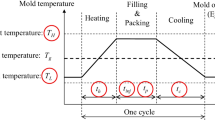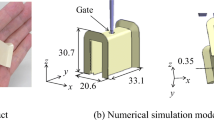Abstract
Weldlines are one of the major defects in plastic injection molding (PIM). The weldlines have an influence on not only the appearance of product but also the strength, so it is important to reduce the weldlines as much as possible. The melt plastic will be quickly solidified with the low weldline temperature that makes the weldlines long. On the other hand, clamping force also affects the product quality, but the relationship between the weldlines and the clamping force is rarely discussed in the literature. In this paper, the minimum weldline temperature is maximized for the weldlines reduction, whereas the clamping force is minimized for the high product quality. Therefore, a multi-objective design optimization of the process parameters is performed and the pareto-frontier between them is identified. Numerical simulation in PIM is generally so intensive that a sequential approximate optimization using a radial basis function network is used to identify the pareto-frontier. 3D cooling channel is used for the design optimization. Through the numerical simulation, the trade-off between the minimum weldline temperature and the clamping force is clarified. In addition, it is found that the 3D cooling channel is effective for the weldlines reduction and clamping force minimization, compared with the straight-type cooling channel. Finally, to examine the validity of the proposed approach, the experiment using the PIM machine (GL30-LP, Sodick) is carried out. It is found through the experimental result that the weldlines are reduced by the proposed approach.
Similar content being viewed by others
References
Chang RY, Yang WH (2001) Numerical simulation of mold filling in injection molding using a three-dimensional finite volume approach. Int J Numer Methods Fluids 37:125–148
Bikas A, Pantelelis N, Kanarachos A (2002) Computational tools for the optimal design of the injection moulding process. J Mater Process Technol 122:112–126
Lam YC, Britton GA, Deng YM (2003) A computer-aided system for an optimal moulding conditions design using a simulation-based approach. Int J Adv Manuf Technol 22:574–586
Dang XP (2014) General frameworks for optimization of plastic injection molding process parameters. Simul Model Pract Theory 41:15–27
Kurtaran H, Ozcelik B, Erzurumlu T (2005) Warpage optimization of a bus ceiling lamp base using neural network and genetic algorithm. J Mater Process Technol 169:314–319
Kurtaran H, Erzurumlu T (2006) Efficient warpage optimization of thin shell plastic parts using response surface methodology and genetic algorithm. Int J Adv Manuf Technol 27:468–472
Shen C, Wang L, Cao W (2007) Optimization for injection molding process conditions of the refrigerator top cover using combination method of artificial neural network and genetic algorithms. Polym-Plast Technol Eng 46:105–112
Chiang KT, Chang FP (2007) Analysis of shrinkage and warpage in an injection-molded part with a thin shell feature using the response surface methodology. Int J Adv Manuf Technol 35:468–479
Gao Y, Wang X (2008) An effective warpage optimization method in injection molding based on the Kriging model. Int J Adv Manuf Technol 37:953–960
Gao Y, Wang X (2009) Surrogate-based process optimization for reducing warpage in injection molding. J Mater Process Technol 209:1302–1309
Zhang Y, Deng YM, Sun BS (2009) Injection molding warpage optimization based on a mode-pursuing sampling method. Polym Plast Technol Eng 48:767–774
Deng YM, Zhang Y, Lam YC (2011) A hybrid of mode-pursuing sampling method and genetic algorithm for minimization of injection molding warpage. Mater Des 31:2118–2123
Li C, Wang FL, Chang YQ, Liu Y (2010) A modified global optimization method based on surrogate model and its application in packing profile optimization of injection molding process. Int J Adv Manuf Technol 48:505–511
Shi H, Gao Y, Wang X (2010) Optimization of injection molding process parameters using integrated artificial neural network model and expected improvement function method. Int J Adv Manuf Technol 48:955–962
Xia W, Luo B, Liao XP (2011) An enhanced optimization approach based on Gaussian process surrogate model for process control in injection molding. Int J Adv Manuf Technol 56:929–942
Cheng J, Liu Z, Tan J (2013) Multiobjective optimization of injection molding parameters based on soft computing and variable complexity method. Int J Adv Manuf Technol 66:907–916
Shi H, Xie S, Wang X (2013) A warpage optimization method for injection molding using artificial neural network with parametric sampling evaluation strategy. Int J Adv Manuf Technol 65:343–353
Kitayama S, Onuki R, Yamazaki K (2014) Warpage reduction with variable pressure profile in plastic injection molding via sequential approximate optimization. Int J Adv Manuf Technol 72:827–838
Zhao J, Cheng G, Ruan S, Li Z (2015) Multi-objective optimization design of injection molding process parameters based on the improved efficient global optimization algorithm and non-dominated sorting-based genetic algorithm. Int J Adv Manuf Technol 78:1813–1826
Xu, G., Yang, Z., (2015), Multiobjective optimization of process parameters for plastic injection molding via soft computing and grey correlation analysis, Int J Adv Manuf Technol, 78: 525–536.
Chen WC, Nguyen MN, Chiu WH, Chen TN, Tai PH (2016) Optimization of the plastic injection molding process using the Taguchi method, RSM, and hybrid GA-PSO. Int J Adv Manuf Technol 83:1873–1886
Li H, Guo Z, Li D (2007) Reducing the effects of weldlines on appearance of plastic products by Taguchi experimental method. Int J Adv Manuf Technol 32:927–931
Chen MY, Tzeng HW, Chen YC, Chen SC (2008) The application of fuzzy theory for the control of weld line positions in injection-molded part. ISA Trans 47:119–126
Wu CY, Ku CC, Pai HY (2011) Injection molding optimization with weld line design constraint using distributed multi-population genetic algorithm. Int J Adv Manuf Technol 52:131–141
Deng YM, Zheng D, Lu XJ (2008) Injection moulding optimization of multi-class design variables using a PSO algorithm. Int J Adv Manuf Technol 39:690–698
Kim KH, Park JC, Suh YS, Koo BH (2017) Interactive robust optimal design of plastic injection products with minimum weldlines. Int J Adv Manuf Technol 88:1333–1344
Yin F, Mao H, Hua L (2011) A hybrid of back propagation neural network and genetic algorithm for optimization of injection molding process parameters. Mater Des 32:3457–3464
Zhai M, Xie Y (2010) A study of gate location optimization of plastic injection molding using sequential liner programming. Int J Adv Manuf Technol 49:97–103
Kitayama S, Natsume S (2014) Multi-objective optimization of volume shrinkage and clamping force for plastic injection molding via sequential approximate optimization. Simul Model Pract Theory 48:35–44
Zhang J, Wang J, Lin J, Guo Q, Chen K, Ma L (2016) Multiobjective optimization of injection molding process parameters based on Opt LHD, EBFNN, and MOPSP. Int J Adv Manuf Technol 85:2857–2872
Sachs E, Wylonis E, Allen S, Cima M, Guo H (2000) Production of injection molding tooling with conformal cooling channels using the three dimensional printing process. Polym Eng Sci 40(5):1232–1247
Xu, X., Sachs, E., Allen, S., (2001), The design of conformal cooling channels in injection molding tooling, Polym Eng Sci, 41(7): 1265–1279
Ferreira JC, Mateus A (2003) Studies of rapid soft tooling with conformal cooling channels for plastic injection moulding. J Mater Process Technol 142:508–516
Dimla DE, Camilotto M, Miani F (2005) Design and optimisation of conformal cooling channels in injection moulding tools. J Mater Process Technol 164-165:1294–1300
Au KM, Yu KM (2007) A scaffolding architecture for conformal cooling design in rapid plastic injection moulding. Int J Adv Manuf Technol 34:496–515
Kitayama S, Miyakawa H, Takano M, Aiba S (2017) Multi-objective optimization of injection molding process parameters for short cycle time and warpage reduction using conformal cooling channel. Int J Adv Manuf Technol 88:1735–1744
Kitayama S, Arakawa M, Yamazaki K (2011) Sequential approximate optimization using radial basis function network for engineering optimization. Optim Eng 12:535–557
Shayfull Z, Sharif S, Zain AM, Ghazali MF, Saad RM (2014) Potential of conformal cooling channels in rapid head cycle molding: a review. Adv Polym Technol 33. https://doi.org/10.1002/adv.21381.
Zhou M, Alexandersen J, Sigmund O, Pedersen CB (2016) Industrial application of topology optimization for combined conductive and convective heat transfer problems. Struct Multidiscip Optim 54:1045–1060
Coffin P, Maute K (2016) Level set topology optimization of cooling and heating devices using a simplified convection model. Struct Multidiscip Optim 53:985–1003
Lohan DJ, Dede EM, Allison JT Topology optimization for heat conduction using generative design algorithms. Struct Multidiscip Optim. https://doi.org/10.1007/s0158-016-1563-6
Deb, K.(2001) Multi-objective optimization using evolutionary algorithms, Wiley .
Author information
Authors and Affiliations
Corresponding author
Rights and permissions
About this article
Cite this article
Kitayama, S., Tamada, K., Takano, M. et al. Numerical and experimental investigation on process parameters optimization in plastic injection molding for weldlines reduction and clamping force minimization. Int J Adv Manuf Technol 97, 2087–2098 (2018). https://doi.org/10.1007/s00170-018-2021-y
Received:
Accepted:
Published:
Issue Date:
DOI: https://doi.org/10.1007/s00170-018-2021-y




